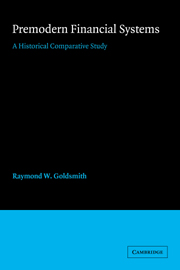Book contents
- Frontmatter
- Contents
- List of tables
- Preface
- 1 Introduction
- 2 The financial systems of the ancient Near East
- 3 The financial system of Periclean Athens
- 4 The financial system of Augustan Rome
- 5 The financial system of the early Abbasid caliphate
- 6 The financial system of the Ottoman Empire at the death of Suleiman I
- 7 The financial system of Mughal India at the death of Akbar
- 8 The financial system of early Tokugawa Japan
- 9 The financial system of Medici Florence
- 10 The financial system of Elizabethan England
- 11 The financial system of the United Provinces at the Peace of Münster
- 12 Similarities and differences
- Notes
- Bibliography
- Index
5 - The financial system of the early Abbasid caliphate
Published online by Cambridge University Press: 05 March 2012
- Frontmatter
- Contents
- List of tables
- Preface
- 1 Introduction
- 2 The financial systems of the ancient Near East
- 3 The financial system of Periclean Athens
- 4 The financial system of Augustan Rome
- 5 The financial system of the early Abbasid caliphate
- 6 The financial system of the Ottoman Empire at the death of Suleiman I
- 7 The financial system of Mughal India at the death of Akbar
- 8 The financial system of early Tokugawa Japan
- 9 The financial system of Medici Florence
- 10 The financial system of Elizabethan England
- 11 The financial system of the United Provinces at the Peace of Münster
- 12 Similarities and differences
- Notes
- Bibliography
- Index
Summary
Within a generation of their crossing the border of the peninsula in a.d. 632, the Arab armies conquered most of the territories of the Byzantine Empire and destroyed the Sassanid Empire. In the following century they added substantial territories in the East and particularly in the West so that their empire in the early eighth century extended from the Indus to the Provence. As a result of the replacement of the Omayyad by the Abbasid dynasty in a.d. 752, most of North Africa as well as Spain became independent, in fact reducing the population of the caliphate by about one-fourth and shifting its political and economic center from Syria to Mesopotamia and Iran and the capital from Damascus to Baghdad. The conquest had been so rapid, the number of conquerors so small, and the economic and cultural level of the conquered territory so much higher than that of Arabia that the caliphate in most fields took over the existing Byzantine or Sassanid institutions with only little change, the most important one being the conversion of a substantial part of the population to Islam and from the eighth century on the use of Arabic as the sole official language. This was done to such an extent that the Omayyad caliphate has been called the neo-Byzantine Empire and the Abbasid caliphate the neo-Sassanid Empire.
- Type
- Chapter
- Information
- Premodern Financial SystemsA Historical Comparative Study, pp. 60 - 79Publisher: Cambridge University PressPrint publication year: 1987



